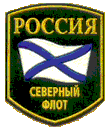






 The mission of the Northern Fleet is to defend Russia's far northwestern Arctic region surrounding the Kola Peninsula. The Soviet Fleet of the Northern Seas was established in 1933, and in 1937 it was renamed the Northern Fleet. The rise of Northern Fleet to a position of preeminence in the Soviet Navy under Admiral Sergei Gorshkov was associated with nuclear power and nuclear weapons. The Northern Fleet became the primary basing area for the largest concentration of Soviet nuclear-powered surface and submarine forces. The Soviet Union developed the world's largest fleet of nuclear-powered icebreakers. Nuclear power plants provided the electricity for the region's vast military-industrial complex. Once an ocean-going force, the Northern Fleet's principal mission is now to defend Russian borders.
The mission of the Northern Fleet is to defend Russia's far northwestern Arctic region surrounding the Kola Peninsula. The Soviet Fleet of the Northern Seas was established in 1933, and in 1937 it was renamed the Northern Fleet. The rise of Northern Fleet to a position of preeminence in the Soviet Navy under Admiral Sergei Gorshkov was associated with nuclear power and nuclear weapons. The Northern Fleet became the primary basing area for the largest concentration of Soviet nuclear-powered surface and submarine forces. The Soviet Union developed the world's largest fleet of nuclear-powered icebreakers. Nuclear power plants provided the electricity for the region's vast military-industrial complex. Once an ocean-going force, the Northern Fleet's principal mission is now to defend Russian borders.
The Northern Fleet is headquartered at Severomorsk, at the top of the Kola Peninsula near Murmansk, with additional home ports at Kola, Motovskiy, Gremikha, and Ura Guba. In May 1984, a five-day series of explosions at Severmorsk reportedly destroyed up to one-third of the Northern Fleet's SAM stockpile, as well as other missiles and munitions.
The Russian Northern Fleet underwent significant changes since the disintegration of the Soviet Union in 1991. Since the end of the Cold War the total number of ships in the Northern Fleet declined by 40%, with many ships placed in reserve status. As of 1996 the fleet provided home ports for thirty-seven nuclear submarines, twenty-two other submarines, forty-seven principal surface combatants, and ten coastal and smaller ships. The naval aviation contingent included a complement of twenty Su-39 fixed-wing aircraft and ten antisubmarine warfare helicopters on board the Admiral Kuznetsov , which heads the air defense of the Barents Sea. Shore-based naval aviation included 200 combat aircraft and sixty-four helicopters. The Northern Fleet has two naval infantry brigades, one coastal defense regiment, and an air defense missile regiment.
In 1989 the Soviet Navy had nearly 200 nuclear submarines in operation, while by 1996 barely half this number was in service, of which two-thirds belonged to the Northern Fleet. Principal concerns with respect to the Russian Northern Fleet are related to de-fuelling activities and laid-up submarines still containing nuclear fuel. Given the former Soviet Union's inadequate management of nuclear and chemical wastes from industrial and military activities, and the associated health and environmental risks, these efforts are critical. The case against environmentalist and former Soviet Navy Captain Aleksandr Nikitin raised questions about Russia's commitment to international standards of human rights. Nikitin was arrested in early 1996 for his role in publishing a report on the nuclear hazards posed by the decaying Russian Northern Fleet. The prosecution's case is based on secret decrees, which were issued after Nikitin's arrest and released to Nikitin and his attorney only after the trial began. Russian authorities have admitted the theft of substantial quantities of highly-enriched uranium within their own borders. A Russian naval officer on trial in Murmansk for having stolen 4 kg of 20%-enriched U235 in November 1993 has described how he simply walked straight into a poorly guarded storage area in Severomorsk (headquarters of the Russian Northern Fleet), forced a padlock on a door, and walked out with several canisters of nuclear fuel rods.